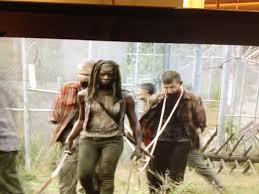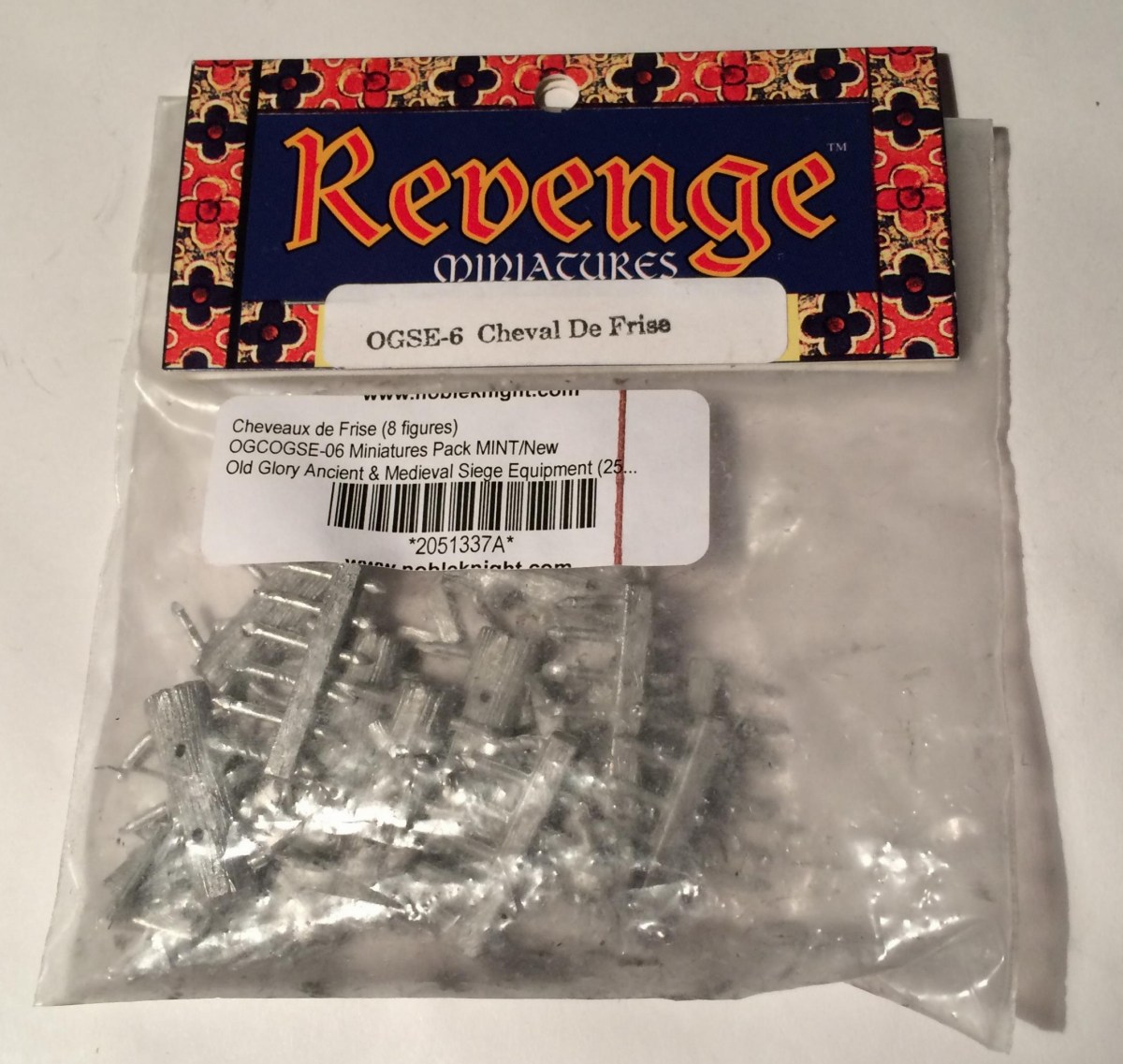While I have been collecting many different fantasy miniatures this year, I have really wanted more terrain and obstacles for the tabletop. I was happy to come across this out of print (OOP) chevaux de fries collection from Old Glory Miniatures. This was acquired from Noble Knight Games which has a lot of OOP stuff. As a former Combat Engineer, I looked forward to installing real obstacles on the battlefield! Yes, “installing” is the word we Engineers would use – but I digress.
We have had the use of chevaux de fries in the fantasy miniatures rules for a while. However, I was never happy with my ad hoc representations. I have also known what chevaux de fries actually were physically in medieval days, but I was less familiar with their origin. I did some research, and I thought it would be useful to give a general historical background on them for the curious.
The term is of course French with the singular being cheval de fries and the plural being chevaux de fries. Typically these were mainly anti-cavalry defensive obstacles, but they could slow up infantry as well on land, and there were naval versions as well.
They were often constructed using logs with iron or metal spikes or spears jutting through drilled holes. The spikes could also be mounted on wooden frames. They were used from medieval times up to and including modern times.
Fellow USMA graduates will remember the stories of the Great Chain at West Point during the Revolutionary War. This was a massive iron chain with sharpened logs that was designed to deny the British Navy the ability to use the Hudson River from New York City to Canada in either direction as a means of communications. This employment denied the British the ability to isolate New England from the other colonies.

Many early Civil War photographs exist depicting the uses of chevaux de fries such as the examples here from Atlanta and Petersburg during the Civil War.


In WWI and WWII they were used to plug gaps in barbed wire defenses. Engineers devised the knife rest as a way to plug gaps in wire obstacles that could allow for passage through those gaps by friendly forces. They are even used today as a way to block roads and the like.

With horse cavalry scarce as a threat, in WWII Europe, chevaux de fries morphed into “hedgehogs” that were employed as anti-landing craft defenses on beaches and anti-tank defenses on fortified lines. I am sure that most would remember from movies and war footage the welded steel I-beam structures such as were used by the Germans on the Normandy Beaches or the Siegfried Line.

The advent of barbed wire and the demise of horse cavalry has led to the obsolescence of this trusty defensive tool. However, chevaux de fries have recently showed up in popular culture as well recently. I do remember their uses against Walkers in two episodes of The Walking Dead – one to reinforce the prison gate and a second by Morgan when he was in Rick’s home town. They were effective against the Walkers, as the walkers would impale themselves and get stuck.

The term chevaux de fries has its origins in medieval times. Frisia is an area from roughly medieval coastal Holland and northern Belgium to Denmark.
Chevaux de fries means, literally, “Frisian Horse”. Apparently the Frisians had little cavalry and first used chevaux de fries to defend against cavalry attacks. Whether this was derisive or not on the part of the French or whomever no one knows – but the term stuck.
Let me get back now to the miniatures! I found these on Noble Knight Games and got them for $14.95. Note the misspelling on the label on the bag!

The misspelled label on the package said 8 figures, but really it was a set of 6 pairs of chevaux de fries. Each set consisted of a log with spear-like wooden iron-tipped spikes and a wooden saw horse structure with screw-shaped iron spikes. I got them out of the package, cleaned all the pieces with a brush and dishwashing soap, and was surprised to see how many tiny pieces there were that needed assembly! There were also extra pieces that could have been flash or the bottom of the spikes.
I picked the best ones for stave pieces and moved on to assembling them with E6000 epoxy. Thankfully, I was able to effectively use my pin vise to make available some of the holes in the saw horses that were not well molded. My goal was to put these together to look as field expedient as possible – as if they were hastily made. These would have been made on-demand as needed for a battle, and I did not want them to look too polished.

After putting them together I realized that basing them first for painting was the best option. This would lead to some crazy angles in getting paint on the the undersides of the miniatures. However, the models were just not sturdy enough without bases. I decided the I would use my scroll saw to cut 1.5″ square bases from 1/8″ balsa. I affixed the models to the bases with my strong wood glue and that proved to be a good call.

I then primed the six with black Krylon primer spray paint. I then base-coated the miniatures and the bases. With some nostalgia, I used up the last of my vintage 1984 Polly-S Jungle Green on the bases. I must have used this paint on many figures over the years. I painted the logs with a combination of Americana Raw Umber and Americana Raw Sienna. I envisioned the sawhorses as being made from fresh lumber, so I base-coated them with a combination of Americana Raw Sienna and Americana Desert Sand, lightening and highlighting them with more of the latter on subsequent coats. The iron rods in the saw horses and the iron tips of the staves were painted with Citadel Mechanized Gray. The stave shafts in the logs were painted with Musket Brown from Armory (still some left over from 1996).

I then dry brushed the logs with Apple Barrel Pewter Gray which gave nice detail to the bark. I the used a couple of wash applications with Secret Weapons Washes to add a a bit more realism – Red-Black on the wood logs and the saw horse frames and Heavy Body Black on the iron parts.

I then had the task of flocking and detailing the bases – on which I used three Army Painter’s products. I used a slurry of water and Elmer’s White Glue to affix two coats of Grass Green flocking. I then used Krylon Clear Matte spray varnish to protect the paint and stabilize the flocking before adding the final touches. These were the addition of a combination of both 4mm Wilderness Tuft and 6mm Wasteland Tuft. I found easier to attach these grasses with wood glue than with the Elmer’s. I like the finished products, andeagerly await the chance to deploy some archers behind them!







One thought on “CHEVAUX DE FRISE (Old Glory Miniatures)”